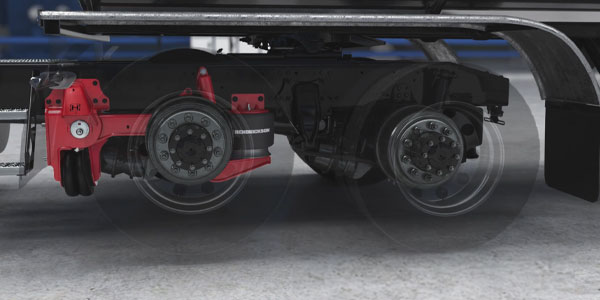There is value that goes beyond decreased tire wear when spec’ing lift axles
Lift axles aren’t the first axle option that comes to mind for long-haul, over-the-road applications. But fleet managers would be wise to reconsider their go-to spec when looking to boost fuel efficiency and equipment operation savings. Sure, there’s the obvious benefit of tire wear savings; then there are some not-so-obvious areas where lift axles are elevating operational savings expectations that might just come as a surprise.
1. Fuel efficiency
By eliminating one driven axle and operating in the forward liftable tandem position, fuel savings are notably improved. For example, independent testing done at Hendrickson on its OPTIMAAX® showed that a six by two configuration could lead to up to a 3% improvement in fuel economy. When the tractor is lightly loaded enough to raise the OPTIMAAX axle, it adds an additional 2%, approximately.
“Compared to a traditional 6×4 configuration, a lightly loaded tractor with a 6×2 OPTIMAAX® configuration has up to 5% fuel economy,” confirmed Mark Williamson,manager, product marketing and tech services, truck commercial vehicle systems, Hendrickson. “That’s pretty tremendous, especially when fuel is so expensive.”
2. Weight savings
This is one of the biggest draws for the use of lift axles. Lighter weight equipment means increased freight efficiency. In the case of Hendrickson’s OPTIMAAX®: The 6×2 liftable axle configuration offers up to a 400-lb. weight savings compared to a traditional 6×4 spec.
Speaking of the 6×2 configuration, there’s always the question of traction—will that 6×2 configuration be enough to get the load moving?
“With OPTIMAAX®, the lift axle is in the forward position and the driven axle is behind the fifth wheel. It’s a different configuration from most 6x2s and it helps,” Williamson noted. “Then you have automatic traction control and ABS that work together. Without those technologies, we wouldn’t have OPTIMAAX®.
“Automatic traction control detects wheel slip. When it does, we have the ability to load bias,” he continued. “It’s not instantaneous, it takes a little time to react fully and bias the weight, but it does put the rated axle capacity load on the driven axle.”
These aren’t 2014’s 6×2 configurations.
3. Toll savings
This one may surprise you. Toll expenses are a significant cost, especially in states like Illinois, New York, and New Jersey. With OPTIMAAX®, fleets can register their trucks with a reduced number of axles on the ground, leading to potential toll savings. Consider a toll heavy route where you run loaded one way, empty the other and you have one less axle on the ground coming back. That savings adds up quickly.
Williamson noted that vehicle registration details are important when it comes to achieving toll savings via liftable axles—and that he has worked with many customers to get it right and be able to realize those savings.















